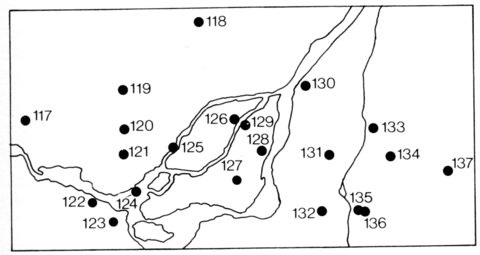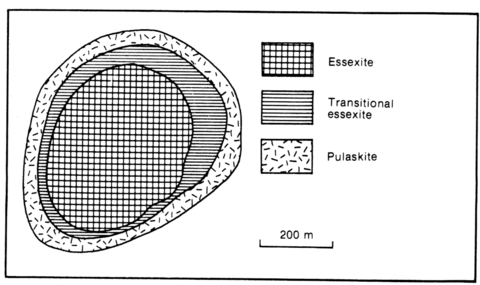stripes
The smallest and best exposed of the Monteregian intrusions, Mount Johnson is a nearly circular plug approximately 680 m in diameter. The core consists of essexites which are intrusive into the surrounding transition unit which passes into a peripheral pulaskite. Rocks of the two outer units are strongly foliated, and marked by mineral concentrations and the vertical alignment of feldspar laths. The foliation is vertical and concentric about the core. There is rhythmic layering within the essexite, with cross-layering or cross-bedding suggesting that the more marginal layers were formed earlier. The central rock is an oligoclase essexite with a little olivine, consisting of oligoclase, augite, biotite, kaersutite and nepheline. This is succeeded outwards by an amphibole-rich essexite in which pyroxene and olivine are absent. There is then a steady increase in feldspar and decrease in amphibole, nepheline and biotite as the margin is approached. In the last 10 m the nepheline content of the pulaskite increases to produce a nepheline syenite. The surrounding, flat lying, Ordovician Lorraine siltstones reach the hornblende hornfels facies in the contact aureole, and close to the intrusion develop an inward dip. There are no contact breccias, and only one dyke has been found cutting the hornfelses, but it is a camptonite containing syenite ocelli and has been described in some detail (Philpotts, 1976, p. 1154) and interpreted in terms of liquid immiscibility, a mechanism applied by Eby (1979) to Mount Johnson itself. Major and trace element chemistry, including REE and Sr isotopes, together with some data on pyroxene and olivine compositions will be found in Eby (1984a) and Pb isotope data in Eby (1985b).
EBY, G.N. 1979. Mount Johnson, Quebec - an example of silicate-liquid immiscibility? Geology, 7: 491-4.
EBY, G.N. 1984a. Monteregian Hills I. Petrography, major and trace element geochemistry, and strontium isotopic chemistry of the western intrusions: Mounts Royal, St. Bruno, and Johnson. Journal of Petrology, 25: 421-52.
EBY, G.N. 1984b. Geochronology of the Monteregian Hills alkaline igneous province, Quebec. Geology, 12: 468-70.
EBY, G.N. 1985b. Sr and Pb isotopes, U and Th chemistry of the alkaline Monteregian and White Mountain igneous provinces, eastern North America. Geochimica et Cosmochimica Acta, 49: 1143-53.
FAIRBAIRN, H.W., FAURE, G., PINSON, W.H., HURLEY, P.M. and POWELL, J.L. 1963. Initial ratio of strontium 87 to strontium 86, whole- rock age, and discordant biotite in the Monteregian igneous province, Quebec. Journal of Geophysical Research, 68: 6515-22.
PHILPOTTS, A.R. 1972. Monteregian Hills: Mounts Johnson and Rougemont. 24th International Geological Congress, Canada, Excursion Guide, B-14: 1-17.
PHILPOTTS, A.R. 1976. Silicate liquid immiscibility: its probable extent and petrogenetic significance. American Journal of Science, 276: 1147-77.


